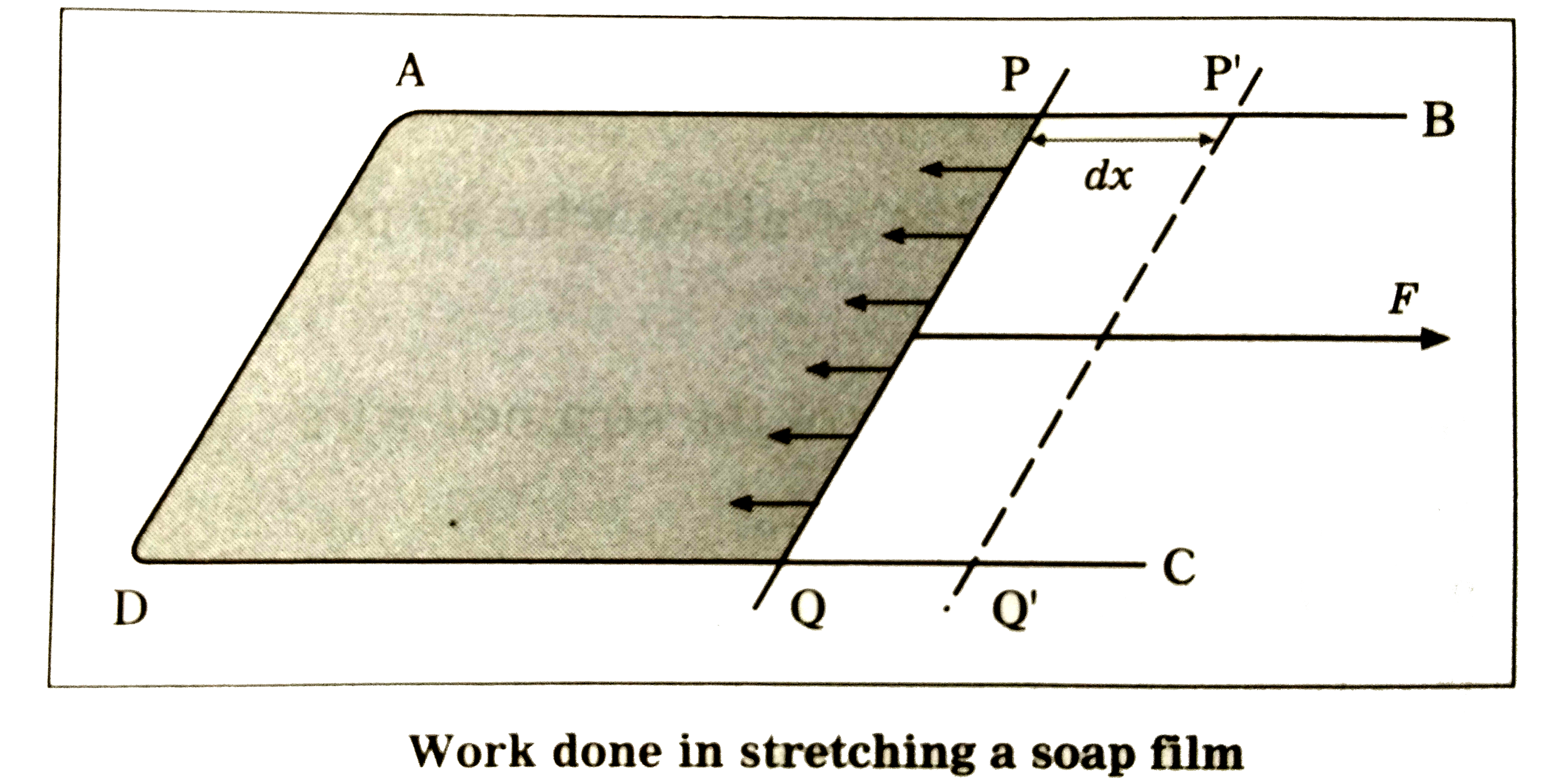Surface tension of a liquid is numerically equal to
Suppose a soap film is isothermally stretched over the area enclosed by a U-shaped frame ABCD and a movable cros-piece PQ. as shown in the figure. Let T be the surface tension of the soap solution and l, the length of wire PQ in contact with the soap film.
The film has two sufaces. Hence, the net force on the wire PQ is 2T l.Suppose that wire PQ is pulled outward very slowly through a distance dx to the position P'Q' by an extrenal force F=2T l.

The work done by the extrenal force against the force due to the film is
W=applied force ×displacement
∴W=Fdx=2Tldx
Due to the displacement dx, the surface area of the film increases by
A=2ldx
Thus, the work done per unit surface area is
WA=2Tldx2ldx=T
This work is stored in the unit surface area of the liquid in the form of potential energy and is called the surface. Thus, the surface energy per unit area of a liquid is equal to its surface tension.
Topper's Solved these Questions
- DERIVATIONS-IBook:NAVNEET PUBLICATION - MAHARASHTRA BOARDChapter:DERIVATIONS-IExercise:Wave Motion
Explore 2 Videos
- DERIVATIONS-IBook:NAVNEET PUBLICATION - MAHARASHTRA BOARDChapter:DERIVATIONS-IExercise:Stationary Waves
Explore 5 Videos
- DERIVATIONS-IBook:NAVNEET PUBLICATION - MAHARASHTRA BOARDChapter:DERIVATIONS-IExercise:Elasticity
Explore 2 Videos
- DEFINITIONSBook:NAVNEET PUBLICATION - MAHARASHTRA BOARDChapter:DEFINITIONSExercise:COMMUNICATION SYSTEMS
Explore 3 Videos
- DERIVATIONS-IIBook:NAVNEET PUBLICATION - MAHARASHTRA BOARDChapter:DERIVATIONS-IIExercise:Assignments
Explore 9 Videos
Similar Questions
Define surface energy. Prove that it is numerically equal to the surface tension.
View SolutionSurface tension of a liquid is a molecular phenomenon of liquids involving the force of cohesion among the liquid molecules. It is a scalar quantity and numerically equal to the surface energy. Numerically, it is proved that the potential enenergy of a liquid is maximum on the surface. Sparingly soluble salts and surface active substances decrease the surface tension of the liquid, however, the fairly soluble solute increase is independent of surface area but if depends on the intermolecular force and the temperature.
Surface tension of a liquid is zero at:
View Solution
Knowledge Check
Surface tension in a liquid is due to :
AAdhesive force between moleculesBCohesive force between moleculesCGravitational force between moleculesDElectrical force between molecules.Surface tension of a liquid depends upon .
AIts temperatureBIts vapour pressureCAddition of soapDAll of theseSurface tension of a liquid is a molecular phenomenon of liquids involving the force of cohension along the liquid molecules. It is scalar quantity and is numberically equal to the surface energy. Numerically, it is proved that the potential soluble salts and surfce active substance. Sparingly soluble salts and surface acitve substances decrease the surface tension of the liquid. However, the fairly soluble solutes increase the surface tension of the liquid. Surface tension of a liquid is independent of surface area but it depends on the intemolecular forces and the temperature.
Surface tension of a liquid does not depend on :AtemperatureBintermolecular forcesCsurface areaDsolute dissolved in liquid.
Surface tension of a liquid is a molecular phenomenon of liquids involving the force of cohesion among the liquid molecules. It is a scalar quantity and numerically equal to the surface energy. Numerically, it is proved that the potential enenergy of a liquid is maximum on the surface. Sparingly soluble salts and surface active substances decrease the surface tension of the liquid, however, the fairly soluble solute increase is independent of surface area but if depends on the intermolecular force and the temperature.
Surface tension of a liquid does not depend on :
View SolutionSurface tension of a liquid is a molecular phenomenon of liquids involving the force of cohension along the liquid molecules. It is scalar quantity and is numberically equal to the surface energy. Numerically, it is proved that the potential soluble salts and surfce active substance. Sparingly soluble salts and surface acitve substances decrease the surface tension of the liquid. However, the fairly soluble solutes increase the surface tension of the liquid. Surface tension of a liquid is independent of surface area but it depends on the intemolecular forces and the temperature.
Which among the following is not the unit of surface tension ?
View SolutionSurface tension of a liquid is a molecular phenomenon of liquids involving the force of cohension along the liquid molecules. It is scalar quantity and is numberically equal to the surface energy. Numerically, it is proved that the potential soluble salts and surfce active substance. Sparingly soluble salts and surface acitve substances decrease the surface tension of the liquid. However, the fairly soluble solutes increase the surface tension of the liquid. Surface tension of a liquid is independent of surface area but it depends on the intemolecular forces and the temperature.
Which of the following has the highest surface tension ?
View SolutionSurface tension of a liquid is a molecular phenomenon of liquids involving the force of cohesion among the liquid molecules. It is a scalar quantity and numerically equal to the surface energy. Numerically, it is proved that the potential enenergy of a liquid is maximum on the surface. Sparingly soluble salts and surface active substances decrease the surface tension of the liquid, however, the fairly soluble solute increase is independent of surface area but if depends on the intermolecular force and the temperature.
Which of the following has the highest surface tension ?
View SolutionSurface tension of a liquid is a molecular phenomenon of liquids involving the force of cohension along the liquid molecules. It is scalar quantity and is numberically equal to the surface energy. Numerically, it is proved that the potential soluble salts and surfce active substance. Sparingly soluble salts and surface acitve substances decrease the surface tension of the liquid. However, the fairly soluble solutes increase the surface tension of the liquid. Surface tension of a liquid is independent of surface area but it depends on the intemolecular forces and the temperature.
Whenoil is placed on the surface of hot water, formation of droplets takes place because :
View Solution